
|
The Art of the Poor: The Aesthetic Material Culture of the Lower Classes in Europe 1300-1600
Paperback / softback
Main Details
| Title |
The Art of the Poor: The Aesthetic Material Culture of the Lower Classes in Europe 1300-1600
|
| Authors and Contributors |
Volume editor Rembrandt Duits
|
| Physical Properties |
| Format:Paperback / softback | | Pages:310 | | Dimensions(mm): Height 234,Width 156 |
|
| Category/Genre | Art History |
|---|
| ISBN/Barcode |
9781350214576
|
| Classifications | Dewey:701.03 |
|---|
| Audience | | Tertiary Education (US: College) | |
|---|
| Illustrations |
5 Maps
|
|
Publishing Details |
| Publisher |
Bloomsbury Publishing PLC
|
| Imprint |
Bloomsbury Academic
|
| Publication Date |
21 April 2022 |
| Publication Country |
United Kingdom
|
Description
The history of art in the late Middle Ages and the Renaissance has generally been written as a story of elites: bankers, noblemen, kings, cardinals, and popes and their artistic interests and commissions. Recent decades have seen attempts to recast the story in terms of material culture, but the focus seems to remain on the upper strata of society. In his inclusive analysis of art from 1300 to 1600, Rembrandt Duits rectifies this. Bringing together thought-provoking ideas from art historians, historians, anthropologists and museum curators, The Art of the Poor examines the role of art in the lower social classes of Europe and explores how this influences our understanding of medieval and early modern society. Introducing new themes and raising innovative research questions through a series of thematically grouped short case studies, this book gives impetus to a new field on the cusp of art history, social history, urban archaeology, and historical anthropology. In doing so, this important study helps us re-assess the very concept of 'art' and its function in society.
Author Biography
Rembrandt Duits is Deputy-Curator of the Photographic Collection at the Warburg Institute, London, UK.
ReviewsCan we imagine the late Middle Ages and Renaissance without the sumptuous art and material culture they are known for? This book invites us to consider objects that usually linger in museum depots and are rarely depicted in catalogues and offers a new and unique assessment of the more modest, cheaper and mass-produced commodities that those who were not even moderately well-off could afford. In doing so, this collection of essays opens our eyes to the taste and aesthetic of the vast majority of people and to the everyday objects that are its witnesses. From mass-produced tableware, to pilgrim badges and from frescoes in remote villages to candlesticks, firebacks and woodcuts, the essays in this pioneering collection are treading new ground and creating a new field in the study of material culture along the way. * Dionysios Stathakopoulos, Senior Lecturer in Byzantine History, King's College London, UK * This book is exciting and ground-breaking. It moves the study of the poor beyond depictions of need and charitable response, demonstrating how the lives of the poor were touched by art in their material culture. The multidisciplinary research brings striking insights into the lives of the poor, and shows the wealth of material available to those who seek to understand this large and little explored segment of humanity. * Anne M. Scott, Associate Professor and Honorary Research Fellow, The University of Western Australia, Australia *
|